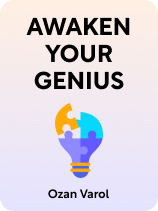

This article is an excerpt from the Shortform book guide to "Awaken Your Genius" by Ozan Varol. Shortform has the world's best summaries and analyses of books you should be reading.
Like this article? Sign up for a free trial here.
What sparks your imagination? How can you tap into your creative potential?
In Awaken Your Genius, Ozan Varol explores techniques for achieving creative fulfillment in your work. He offers insights on building confidence, embracing playfulness, and generating innovative ideas to enhance your creative process.
Keep reading to discover Varol’s strategies for unlocking your creativity and finding greater creative fulfillment.
Tips for Creative Fulfillment
Once you’ve returned to your true self, Varol says you’ll have new opportunities for creative fulfillment. Varol recommends three practices for enhancing your creativity: building creative confidence, playing with your craft, and mining for ideas.
#1: Building Creative Confidence
Many people are held back by self-doubt when it comes to creativity—they worry that they don’t have good ideas, that they can’t create anything worthwhile, or that others won’t like what they create. If these blockages are preventing you from following through on your creative impulses, Varol offers a few techniques for building creative confidence.
Share your ideas. Varol explains that we tend to be more critical of our own ideas than others would be. If you share your ideas with others—even the ideas you think are bad—you might be surprised at how well they’re received. This feedback can boost your confidence and encourage you to further develop your ideas.
(Shortform note: Although sharing your ideas with others could help boost your confidence, it also comes with some risks. One is that, according to artist Austin Kleon in Steal Like an Artist, sharing your creative work with others can lead them to associate you with a specific style or type of idea. This might make them less supportive of future attempts to branch out, limiting your creative freedom. Additionally, when you reveal your ideas prematurely, you risk others appropriating your ideas without giving you credit. This could lead to potential legal battles or losing control over your original work. To mitigate these risks, consider sharing your ideas only with people you trust to be encouraging and respectful of your intellectual property.)
Use your inexpertise to your advantage. Varol says that while not knowing how to approach a creative project can feel daunting, it can also help you. When you understand how things are usually done, you’re more likely to replicate the status quo. When you don’t, you have more mental freedom, so you can experiment with new ways of creating. As you create, keep in mind your unique advantage as a novice. Say you want to write a romance novel, but you don’t know how. Rather than wallowing in self-doubt, use what you already know about romance novels as a starting point and then improvise the rest. What you come up with could break the mold in delightful ways, drawing in readers looking for a unique romance novel.
(Shortform note: This advice echoes the Japanese Zen concept known as shoshin, which means “beginner’s mind.” According to this concept, being an expert in something (or thinking you’re an expert in something) can limit your ability to see new possibilities. In contrast, when you approach a task with a beginner’s mind, you remain open, curious, and free from preconceptions, which allows you to explore and create in innovative ways. As Varol argues, beginners have a major creative advantage, and keeping this in mind can boost your self-confidence. It can also help you if you are an expert—according to Zen beliefs, experts can also learn to have a beginner’s mind if they approach their work with curiosity and humility.)
Welcome failure. Instead of letting your fear of failure stop you from creating, Varol highlights two kinds of failure you should welcome. The first is failure to please everyone. Varol argues that when someone tells you they’re not pleased with your work, they’re doing you a favor: Either they’re telling you how you can improve your work, or they’re telling you that your work isn’t what they expected—which can be a good sign that you’re thinking outside the box. The second kind of failure you should welcome is informative failure—the kind that teaches you an important lesson about your craft by alerting you to a mistake you must correct in the future. You can use informative failure to refine your skills and grow creatively.
(Shortform note: What if your fear of failure is deeply ingrained—how can you learn to welcome it? According to research on people with high-stakes jobs, like bomb defusers, the best way to overcome this fear is by cultivating bravery. One practice that could help you cultivate bravery involves imagining yourself being brave in a situation where you might fail. Another strategy is to refocus: Instead of thinking about how you might fail in the future, think about what’s going on in the present. Finally, understand that, at least in situations where the stakes are relatively low, failure isn’t a big deal in the grand scheme of things—when you look back on times you’ve failed, you’ll likely feel amused, not horrified.)
#2: Playing With Your Craft
Varol argues that many creatives spend too much time trying to improve their craft and not enough time playing with it. Play is experimental and process-driven, rather than predictable and outcomes-driven. Since you’re not focused on accomplishing anything specific, playing enables you to explore new ways of doing things and discover new things to do. This makes play helpful for activities like brainstorming. For example, say you want to write a new song. Instead of starting with a specific theme or structure in mind, you could experiment by humming spontaneous melodies or using unconventional instruments and sounds. You might stumble upon unique combinations and creative ideas that lead to an innovative and original song.
| How to Be More Playful If it’s been a while since you indulged in play, experts recommend these tips for rediscovering your playful side: First, find out what kind of play appeals to you (research suggests there are eight play personalities and eight types of play); then, look for small opportunities to engage in that kind of play. For example, if your play personality is the joker and you enjoy narrative play, you might try writing a joke or bite-sized comedy sketch. Additionally, you might consider scheduling time for play if that helps you commit to it; if you don’t have that kind of free time, you can weave play into your daily routine by, for example, allowing for moments of silliness and fun while you do your housework. Once you feel more in tune with your playful nature, apply that playfulness to your work or craft by approaching projects with curiosity, openness, and an experimental mindset. |
Mining for Ideas
Creativity requires original ideas. Varol offers a few techniques you can use to mine for those ideas.
Make time for contemplation. Varol argues that the ideas that come to you most quickly tend to be conventional, not innovative. Spending time in contemplation allows you to explore less obvious connections and possibilities, which can help you develop truly original ideas.
Use your body to think. Most people conceive of thinking as a purely mental process, but Varol argues that you can use your body to come up with original ideas: Studies suggest that movement can stimulate creativity, and you can also tap into your body’s wisdom to evaluate your ideas. For example, if the thought of pursuing a particular idea makes you feel physically energized and excited, it’s likely a good direction to follow. Conversely, if an idea makes you feel tense or uneasy, it might be worth reconsidering.
Seek others’ opinions. Varol says that most great ideas aren’t developed in isolation. Getting feedback on your ideas from people whose thinking you respect can provide valuable insights and perspectives you may have missed. Additionally, someone else might have expertise that enhances or completes your idea. For example, if you come up with an idea for a new mental health app, you might benefit from collaborating with a software developer who can turn your concept into a functional product.

———End of Preview———
Like what you just read? Read the rest of the world's best book summary and analysis of Ozan Varol's "Awaken Your Genius" at Shortform.
Here's what you'll find in our full Awaken Your Genius summary:
- The reasons why you’ve abandoned your true self so far in life
- A former rocket scientist’s tips for embodying your true self
- How to achieve creative fulfillment and personal growth






